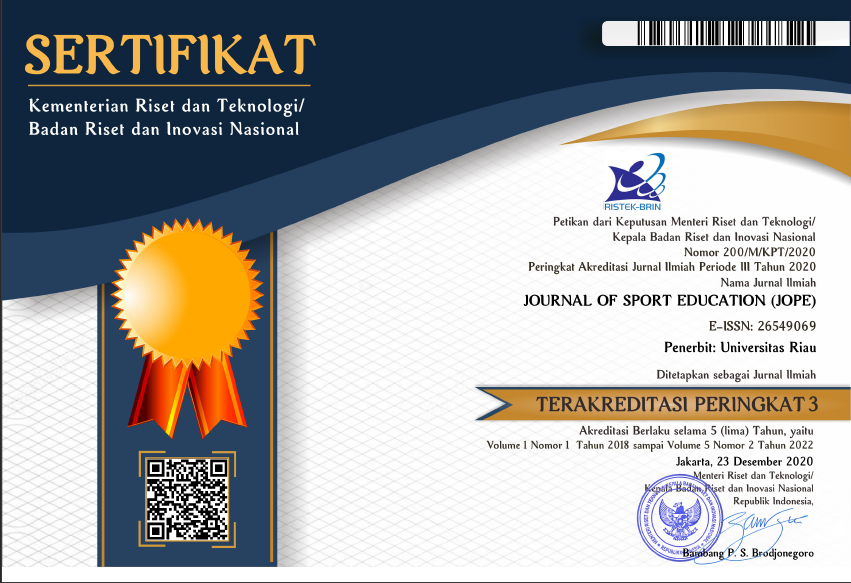Perbandingan karakteristik lompat vertikal pada atlet bulutangkis pria dengan atlet bulutangkis wanita
Abstract
Lompatan pada bulutangkis merupakan gerakan explosive movement, yang memiliki kaitan erat dengan cedera patellar tendinopathy. Tujuan daripada penelitian ini adalah untuk mengukur kemampuan lompat vertikal pada atlete bulutangkis pria dan wanita. Total 49 athlete badminton usia 18-19 tahun berpartisipasi dalam penelitian ini. Secara lebih spesifik mereka dibagi menjadi 2 kategori, yaitu kategori putra n= 26 (tinggi badan = 171.2 ± 6.91 cm ; berat badan = 64.02 ± 9.67 Kg; BMI = 21.89 ± 2.49 Kg/m2), dan kategori putri n=23 (tinggi badan = 159.09 ± 3.40 cm ; berat badan = 56.79 ± 9.40 Kg; BMI = 22.39 ± 3.08 Kg/m2). Seluruh peserta diminta untuk melakukan lompatan vertikal sebanyak dua kali diatas Takei-5414-digital vertical jump meter. Seluruh peserta melakukan tiga jenis gerakan, yaitu lompatan vertikal dengan kaki kanan, lompatan vertikal dengan kaki kiri, dan lompatan vertikal dengan kedua kaki. Statistical analysis menunjukkan bahwa terdapat perbedaan antara pria dan wanita pada lompatan vertikal dengan kaki kiri (p = 0.03), lompatan vertikal dengan kaki kanan (p = 0.02), lompatan vertikal dengan kedua kaki (p = 0.001). Penelitian ini menunjukkan bahwa atlet laki-laki bulutangkis memiliki kemampuan lompatan yang lebih baik dibandingkan dengan atlet bulutangkis wanita.
Copyright © The Author (s) 2021

Keywords
Full Text:
PDFReferences
Alcock, A., & Cable, N. T. (2009). A comparison of singles and doubles badminton: heart rate response, player profiles and game characteristics. International Journal of Performance Analysis in Sport, 9(2), 228–237. https://doi.org/10.1080/24748668.2009.11868479
Ali Rozikin, T. H. (2015). Hubungan fleksibilitas dan kekuatan otot tungkai terhadap hasil tendangan eolgol dollyo-chagi pada olahraga taekwondo. JSSF (Journal of Sport Science and Fitness), 4(1), 32–36.
Apriantono, T., Herman, I., Winata, B., & Hasan, M. F. (2020). Differences of physiological characteristics of taekwondo junior players vs pencak silat junior players, 8(2), 9–15. https://doi.org/10.16926/par.2020.08.15
Apriantono, T., Herman, I., Winata, B., Hidayat, I. I., Hasan, M. F., Juniarsyah, A. D., & Ihsani, S. I. (2020). Physiological characteristics of Indonesian junior badminton players: Men’s double category. International Journal of Human Movement and Sports Sciences, 8(6), 444–454. https://doi.org/10.13189/saj.2020.080617
Arisman, Saripin, A. V. (2017). Hubungan kelentukan pergelangan tangan dan power otot lengan bahu dengan hasil akurasi smash bulutangkis putra pada pb. Angkasa pekanbaru. Journal of Sport Education, 300, 1–10.
Cabello Manrique, D., & González-Badillo, J. J. (2003). Analysis of the characteristics of competitive badminton. British Journal of Sports Medicine, 37(1), 62–66. https://doi.org/10.1136/bjsm.37.1.62
Cece, V. (2020). Mental training program in racket sports: A systematic review. International Journal of Racket Sports Science, 2(1), 55–71. https://doi.org/10.30827/digibug.63721
Deka, P., Berg, K., Harder, J., Batelaan, H., & McGRATH, M. (2017). Oxygen cost and physiological responses of recreational badminton match play. Journal of Sports Medicine and Physical Fitness, 57(6), 760–765. https://doi.org/10.23736/S0022-4707.16.06319-2
Faccini, P., & Dal Monte, A. (1996). Physiologic demands of badminton match play. American Journal of Sports Medicine, 24(SUPPL.), 64–66. https://doi.org/10.1177/036354659602406s19
Faude, O., Meyer, T., Rosenberger, F., Fries, M., Huber, G., & Kindermann, W. (2007). Physiological characteristics of badminton match play. European Journal of Applied Physiology, 100(4), 479–485. https://doi.org/10.1007/s00421-007-0441-8
Harry, J. R., Lanier, R., Nunley, B., & Blinch, J. (2019). Focus of attention effects on lower extremity biomechanics during vertical jump landings. Human Movement Science, 68(September), 102521. https://doi.org/10.1016/j.humov.2019.102521
Herbst, K. L., & Bhasin, S. (2004). Testosterone action on skeletal muscle. Current Opinion in Clinical Nutrition and Metabolic Care, 7(3), 271–277. https://doi.org/10.1097/00075197-200405000-00006
Juang, B. R. (2015). Analisis kelebihan dan kelemahan keterampilan teknik bermain bulutangkis pada pemain tunggal putra terbaik indonesia tahun 2014. Jurnal Kesehatan Olahraga, 3(1), 109–117.
Kurniawati, E., & Sugiyanto, C. (2021). Pengaruh struktur umur penduduk terhadap pertumbuhan ekonomi di indonesia. Jurnal Ekonomi Dan Pembangunan Indonesia, 21(1), 41–58.
Lee, J. J. J., & Loh, W. P. (2019). A state-of-the-art review on badminton lunge attributes. Computers in Biology and Medicine, 108(April), 213–222. https://doi.org/10.1016/j.compbiomed.2019.04.003
Pardiwala, D. N., Subbiah, K., Rao, N., & Modi, R. (2020). Badminton injuries in elite athletes: a review of epidemiology and biomechanics. Indian Journal of Orthopaedics, 54(3), 237–245. https://doi.org/10.1007/s43465-020-00054-1
Phomsoupha, M., & Laffaye, G. (2015). The science of badminton: game characteristics, anthropometry, physiology, visual fitness and biomechanics. Sports Medicine, 45(4), 473–495. https://doi.org/10.1007/s40279-014-0287-2
Ral, a Y. O., Evri, D., & An, D. I. (2006). Vertical jump performance of professional male and female volleyball players: effects of playing position and competition level, 20(3), 572–578.
Rampichini, S., Limonta, E., Pugliese, L., Cè, E., Bisconti, A. V., Gianfelici, A., … Esposito, F. (2018). Heart rate and pulmonary oxygen uptake response in professional badminton players: comparison between on-court game simulation and laboratory exercise testing. European Journal of Applied Physiology, 118(11), 2339–2347. https://doi.org/10.1007/s00421-018-3960-6
Setiawan, A., Effendi, F., & Toha, M. (2020). Akurasi smash forehand bulutangkis dikaitkan dengan kekuatan otot lengan dan koordinasi mata-tangan. Jurnal MAENPO: Jurnal Pendidikan Jasmani Kesehatan Dan Rekreasi, 10(1), 50. https://doi.org/10.35194/jm.v10i1.949
Syahruddin, S., Imam, I. S., Lungit, L., Ramdan, R. P., & Bagus, B. W. (2019). Infrared sensor technology (ist) test as a tool for assessment of flexibility. Postepy Rehabilitacji, 33(3), 5–9. https://doi.org/10.5114/areh.2019.87743
Syaifudin, M. (2013). Olahraga bulutangkis sebagai solusi mengurangi frustasi bagi kalangan pengusaha di yayasan lkk ngesti rahayu sidoarjo. Unesa, 2, 1–4. Retrieved from https://jurnalmahasiswa.unesa.ac.id/index.php/jurnal-kesehatan-olahraga/article/view/2463
Ulil, A., Pratomo, D., & Subiyono, H. S. (2013). Perbedaan hasil latihan umpan balik lob langsung dan lob tak langsung terhadap ketepatan lob dalam olahraga bulutangkis di pb tugu muda kota semarang. Journal of Sport Sciences and Fitness, 2(1), 1–5.
Vanezis, A., & Lees, A. (2005). A biomechanical analysis of good and poor performers of the vertical jump. Ergonomics, 48(11–14), 1594–1603. https://doi.org/10.1080/00140130500101262
Yang, C., Yao, W., Garrett, W. E., Givens, D. L., Hacke, J., Liu, H., & Yu, B. (2018). Effects of an intervention program on lower extremity biomechanics in stop-jump and side-cutting tasks. American Journal of Sports Medicine, 46(12), 3014–3022. https://doi.org/10.1177/0363546518793393
Zhang, B., Li, F., & Jiang, W. (2013). Mixed doubles match technical and tactical analysis of world badminton champion based on mathematical statistics. Advances in Physical Education, 03(04), 154–157. https://doi.org/10.4236/ape.2013.34025
DOI: http://dx.doi.org/10.31258/jope.4.1.10-18
Refbacks
- There are currently no refbacks.











